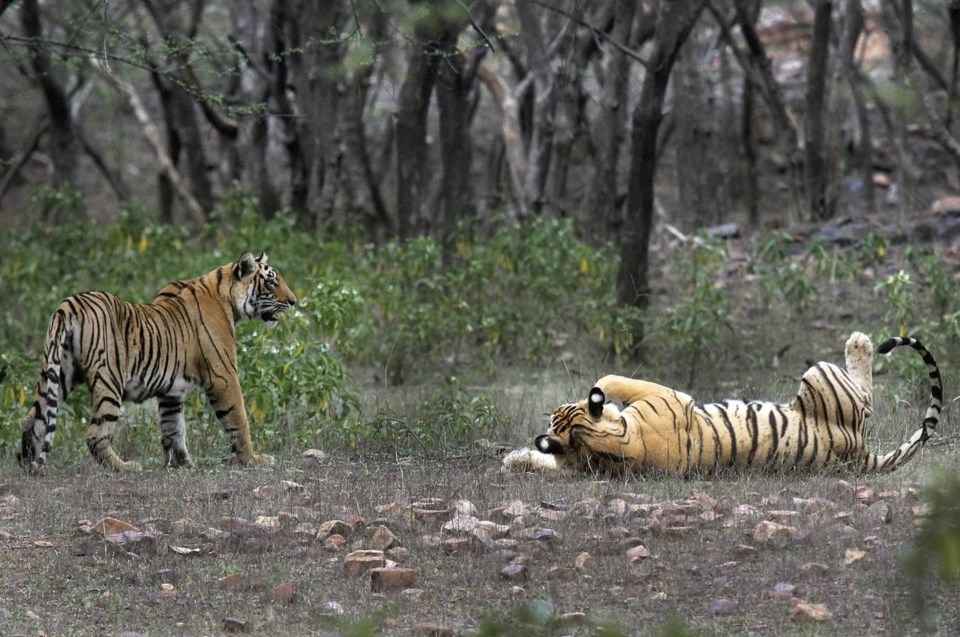BENGALURU, India (AP) — It was a celebratory atmosphere for officials gathered just hours away from several of India's major tiger reserves in the southern city of Mysuru, where Prime Minister Narendra Modi announced Sunday to much applause that the country's tiger population has steadily grown to over 3,000 since its flagship conservation program began 50 years ago after concerns that numbers of the big cats were dwindling.
“India is a country where protecting nature is part of our culture,” Modi proclaimed. “This is why we have many unique achievements in wildlife conservation.”
Modi also launched the International Big Cats Alliance that he said will focus on the protection and conservation of seven big cat species, namely, the tiger, lion, , snow leopard, puma, jaguar and .
Protesters, meanwhile, are telling their own stories Sunday of how they have been displaced by wildlife conservation projects over the last half-century, with dozens demonstrating about an hour away from the announcement.
Project Tiger began in 1973 after a census of the big cats found India’s tigers were fast going extinct through habitat loss, unregulated sport hunting, increased poaching and retaliatory killing by people. It's believed the tiger population was around 1,800 at the time, but experts widely consider that an overestimate due to imprecise counting methods in India until 2006. Laws attempted to address the decline, but the conservation model centered around creating protected reserves where ecosystems can function undisturbed by people.
Several Indigenous groups say the conservation strategies, deeply influenced by American environmentalism, meant uprooting numerous communities that had lived in the forests for millennia.
Members of several Indigenous or Adivasi groups — as Indigenous people are known in the country — set up the Nagarahole Adivasi Forest Rights Establishment Committee to protest evictions from their ancestral lands and seek a voice in how the forests are managed.
“Nagarahole was one of the first forests to be brought under Project Tiger and our parents and grandparents were probably among the first to be forced out of the forests in the name of conservation,” said J. A. Shivu, 27, who belongs to the Jenu Kuruba tribe. “We have lost all rights to visit our lands, temples or even collect honey from the forests. How can we continue living like this?”
Jenu, which means honey in the southern Indian Kannada language, is the tribe’s primary source of livelihood as they collect it from beehives in the forests to sell.
The fewer than 40,000 Jenu Kuruba people are one of the 75 tribal groups that the Indian government classifies as particularly vulnerable. Adivasi communities like the Jenu Kurubas are among the poorest in India.
Some experts say conservation policies that attempted to protect a pristine wilderness were influenced by prejudices against local communities.
The Indian government's tribal affairs ministry has repeatedly said it is working on Adivasi rights. Only about 1% of the more than 100 million Adivasis in India have been granted any rights over forest lands despite a government forest rights law, passed in 2006, that aimed to “undo the historical injustice" for forest communities.
India's tiger numbers, meanwhile, are thriving: the country's 3,167 tigers account for more than 75% of the world’s wild tiger population.
Tigers have disappeared in Bali and Java and China’s tigers are likely extinct in the wild. The Sunda Island tiger, the other sub-species, is only found in Sumatra. India's project to safeguard them has been praised as a success by many.
“Project Tiger hardly has a parallel in the world since a scheme of this scale and magnitude has not been so successful elsewhere,” said SP Yadav, a senior Indian government official in charge of Project Tiger.
But critics say the social costs of fortress conservation — where forest departments protect wildlife and prevent local communities from entering forest regions — is high.
Sharachchandra Lele, of the Bengaluru-based Ashoka Trust for Research in Ecology and the Environment, said the conservation model is outdated.
“There are already several examples of forests used actively by local communities and tiger numbers have actually increased even while people have benefited in these regions,” he said.
Vidya Athreya, the director of Wildlife Conservation Society in India who has been studying the interactions between large cats and humans for the last two decades, agreed.
“Traditionally we always put wildlife over people,” Athreya said, adding that engaging with communities is the way forward for protecting wildlife in India.
Shivu, from the Jenu Kuruba tribe, also wants to go back to a life where Indigenous communities and tigers lived together.
“We consider them gods and us the custodians of these forests,” he said.
___
Aniruddha Ghosal in New Delhi, India, contributed to this report.
___
Follow Sibi Arasu on Twitter at
___
Associated Press climate and environmental coverage receives support from several private foundations. See more about AP’s climate initiative . The AP is solely responsible for all content.
Sibi Arasu, The Associated Press




